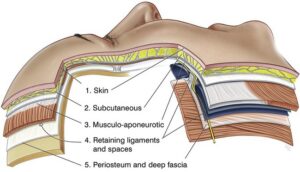SMAS Facelift Technique: A Comprehensive Guide for Patients
The pursuit of a more youthful appearance often leads to the consideration of surgical procedures, with the SMAS facelift being one of the most popular choices. Known for its ability to deliver natural-looking results with long-lasting effects, the SMAS facelift has been a cornerstone in facial rejuvenation surgery for decades. In this comprehensive guide, we’ll explore everything you need to know about the SMAS facelift, including how it compares to the deep plane facelift, the anatomy of the SMAS, the history of the procedure, and the different variations of the SMAS facelift.
What is the SMAS Facelift?
The SMAS (Superficial Musculoaponeurotic System) facelift is a surgical technique that focuses on repositioning the deeper layers of facial tissues to achieve a more youthful contour. The SMAS layer is a network of fibrous tissue and muscles that lies beneath the skin and fat but above the deeper facial muscles. This layer is crucial in maintaining the structural integrity and youthful appearance of the face.
Anatomy of the SMAS
The SMAS is a complex structure that plays a vital role in facial expression and the overall appearance of the face. It extends from the neck up to the forehead and is interconnected with the facial muscles that control expressions such as smiling and frowning. As we age, the SMAS layer loses its elasticity and begins to sag, contributing to the formation of jowls, nasolabial folds, and a less defined jawline.

By targeting the SMAS during a facelift, surgeons can achieve more natural and durable results compared to skin-only facelifts. The repositioning of this deeper layer not only lifts the skin but also restores the underlying facial structure, leading to a more youthful and refreshed appearance.
History of the SMAS Facelift
The SMAS facelift technique was developed in the late 1970s and early 1980s as an advancement over the traditional skin-only facelift. Surgeons recognized that simply tightening the skin often led to an unnatural, “windswept” look and that the results were short-lived as the skin quickly lost elasticity. By incorporating the SMAS layer into the procedure, surgeons were able to create longer-lasting and more natural results.
Over the years, the SMAS facelift has undergone various refinements, with surgeons developing different techniques to address specific patient needs and achieve optimal results. Today, the SMAS facelift remains one of the most widely performed and trusted procedures in facial plastic surgery.
SMAS Facelift vs. Deep Plane Facelift
While the SMAS facelift is highly effective, it is often compared to another popular technique: the deep plane facelift. Both procedures target the deeper layers of facial tissue, but they differ in approach and potential outcomes.
SMAS Facelift:
- Technique: The SMAS facelift involves the elevation and repositioning of the SMAS layer, along with the removal of any excess skin. The SMAS layer is either folded, plicated, or tightened to create a more youthful contour.
- Advantages: This technique allows for significant lifting of the midface and jawline, with minimal disruption to the underlying facial structures. The procedure takes less time to do compared to a deep plane facelift. The results are natural-looking and long-lasting.
- Disadvantages: The SMAS facelift results typically do not last as long as a deep plane facelift.
Deep Plane Facelift:
- Technique: The deep plane facelift goes a step further by releasing and repositioning the deeper layers of the face, including the SMAS and the underlying muscles and retaining ligaments. This technique allows for a more comprehensive lift, particularly in the midface, and can improve the nasolabial folds more effectively.
- Advantages: The deep plane facelift can achieve more dramatic and longer-lasting results, particularly in patients with significant facial sagging. It also reduces the risk of a “pulled” appearance by maintaining the natural relationships between facial tissues. In addition, the deep plane facelift elevates in a deeper level which allows the skin to have a better blood flow. Because of this, there is less risk of fluid collections and skin necrosis after surgery.
Variations of the SMAS Facelift
The SMAS facelift can be customized to address the unique needs of each patient. Some of the common variations include:
- SMAS Plication: In this variation, the SMAS layer is folded over itself and sutured into place. This technique is less invasive and is often used for patients with mild to moderate sagging.
- SMASectomy: This involves the removal of a portion of the SMAS layer before it is tightened and repositioned. This technique is effective for patients with more significant facial sagging and can provide more dramatic results.
- Extended SMAS Facelift: This technique involves a more extensive dissection of the SMAS layer, allowing for greater lifting of the midface and neck. It’s often chosen for patients with more advanced signs of aging.
Who is a Good Candidate for a SMAS Facelift?
The SMAS facelift is ideal for patients who are experiencing moderate to severe facial sagging, particularly in the lower face and neck. It’s best suited for individuals who want to achieve natural-looking results that are long-lasting. Good candidates should be in overall good health, have realistic expectations, and be non-smokers, as smoking can impair healing and affect the results of the surgery.
What to Expect During and After the Procedure
A SMAS facelift is typically performed under general anesthesia and takes 3-4 hours to complete. The surgeon will make incisions around the ears and hairline, allowing access to the SMAS layer. The SMAS is then elevated, repositioned, and secured, with any excess skin removed before closing the incisions.
Recovery from a SMAS facelift involves some swelling and bruising, which usually subsides within 2-3 weeks. Most patients can return to work and normal activities within this time, though it may take several months for the final results to fully develop.
Conclusion
The SMAS facelift remains a gold standard in facial rejuvenation, offering natural-looking and long-lasting results by addressing the deeper layers of facial tissue. Whether you’re comparing it to the deep plane facelift or considering one of its variations, the SMAS facelift provides a versatile and effective solution for those looking to restore a youthful appearance.

